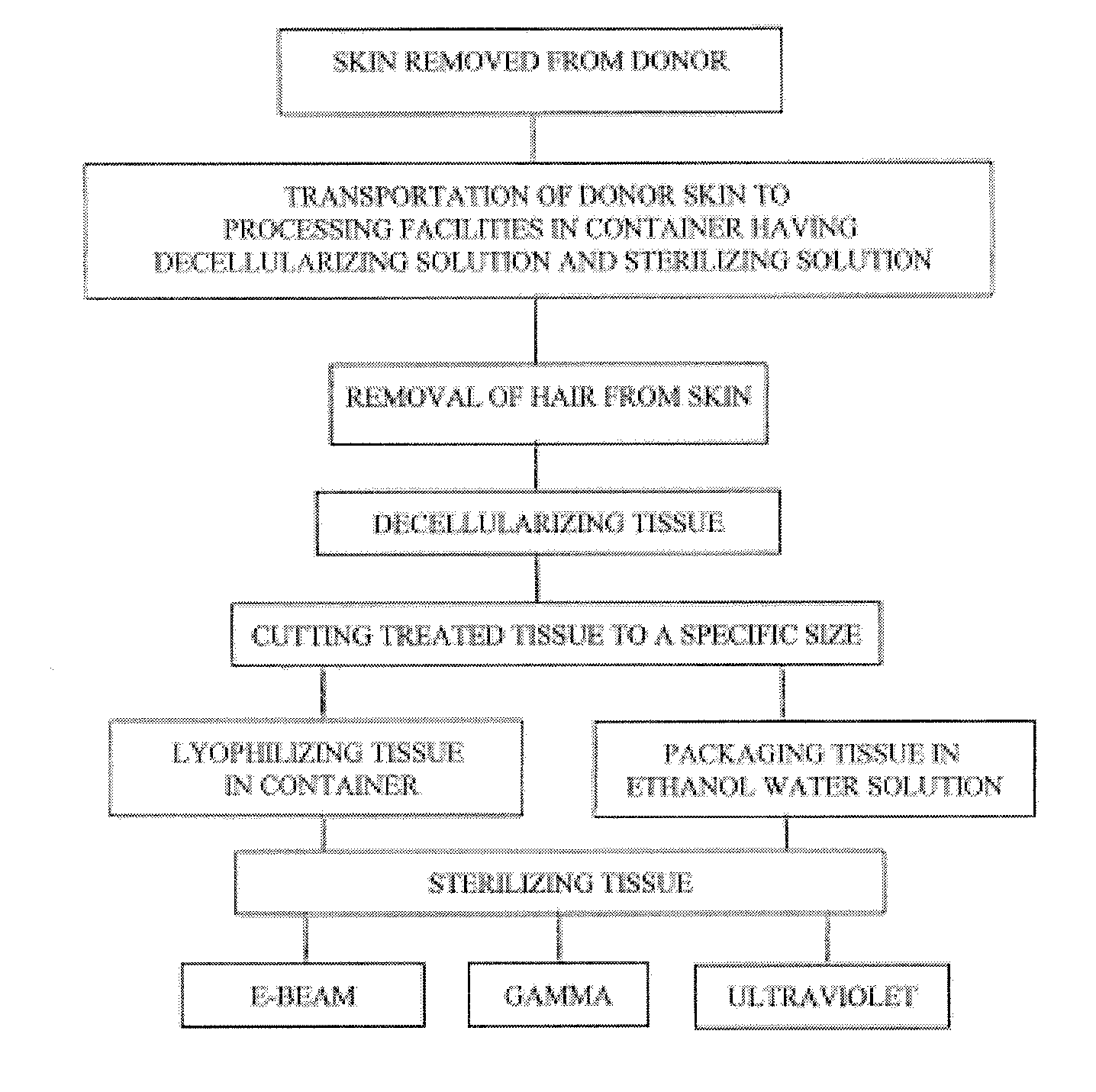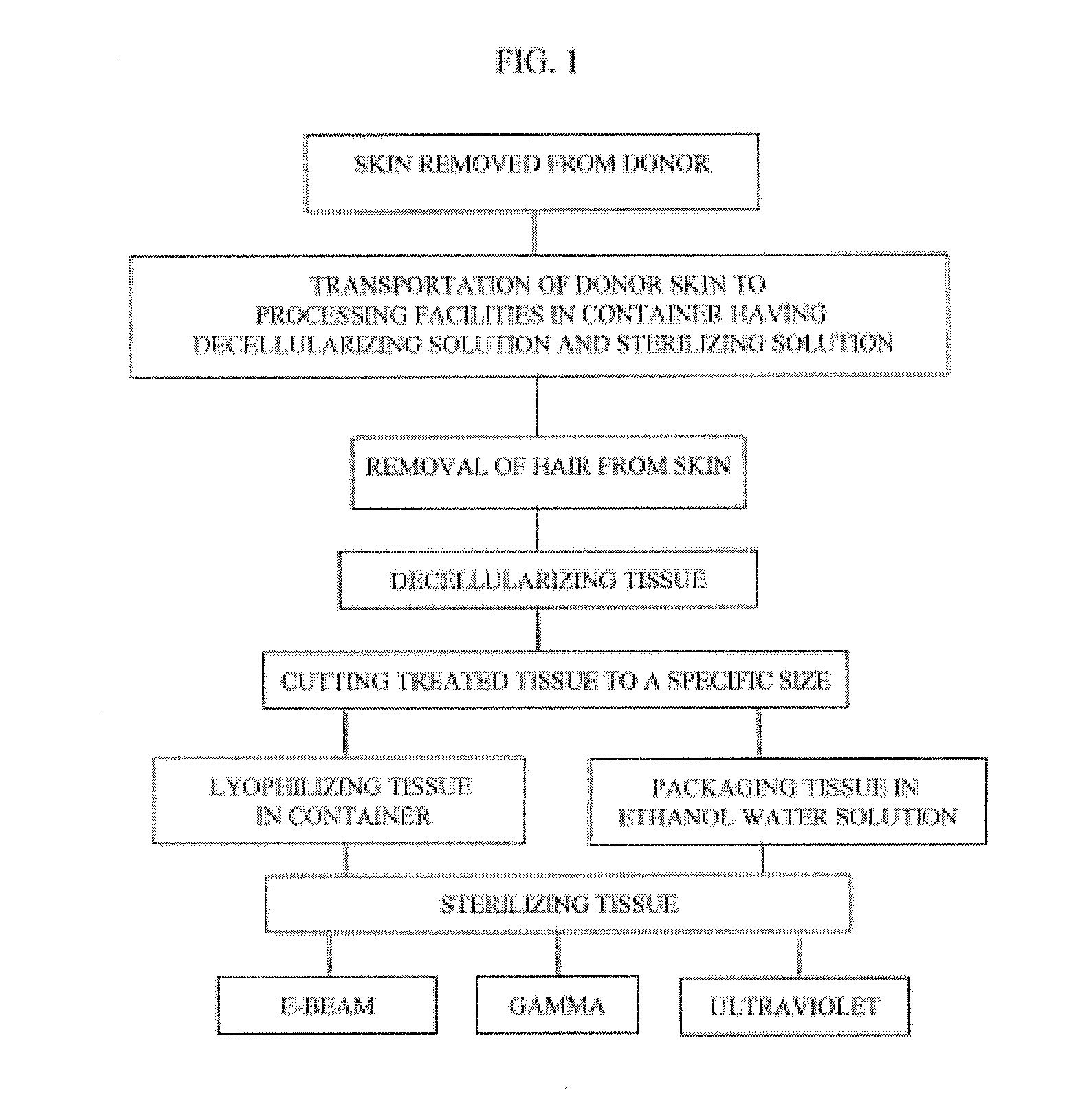Process for sterilizing acellular soft tissue with irradiation
a technology of acellular soft tissue and irradiation, which is applied in the field of soft tissue treatment, can solve the problems of narrow therapeutic window between adequate immunosuppression and toxicity, infection threat, and significant risk of rejection associated with transplantation
- Summary
- Abstract
- Description
- Claims
- Application Information
AI Technical Summary
Benefits of technology
Problems solved by technology
Method used
Image
Examples
example 1
Sterilization of Dermis with E-Beam Irradiation
[0032]The tissue which has been previously obtained from a donor is shipped from the donor site in a container having a sterilization solution mixed with a decellularizing solution such as sodium chloride and then frozen.
[0033]The donor tissue is then thawed and then rinsed to maintain moisture. The thawed tissue is processed by removing hair and is then decellularized using 1M NaCI and 0.1% of Triton X-100. If desired at the time of decellularization one or more of the following protease inhibitors may be added; Aminoethylbenzenesulfonyl fluoride HCL (serine proteases) (25-100 μm, Aprotinin (broad spectrum, serine proteases) (7.5-30 μm), Protease Inhibitor E-64 (cysteine proteases) (0.05-0.0.20 μm), Leupeptin, Hemisulfate (cysteine proteases) (0.05-0.0.20 μm), EDTA, Disodium (0.025-0.0. 10 μm), and trypsin-like proteases, Pepstatin A (Aspartic Proteases), Marmistat (MMP2). The tissue is processed and decellularized and is inspected for...
example 2
Sterilization of Dermis with Gamma Irradiation
[0042]The tissue which has been previously obtained from a donor is shipped from the donor site in a container having a sterilization solution mixed with a decellularizing solution such as sodium chloride and then frozen.
[0043]The donor tissue is then thawed and then rinsed to maintain moisture. The thawed tissue is processed by removing hair and is then decellularized using 1M NaCl and 0.1% of Triton X-100. If desired at the time of decellularization one or more of the following protease inhibitors may be added; Aminoethylbenzenesulfonyl fluoride HCL (serine proteases) (25-100 μm, Aprotinin (broad spectrum, serine proteases) (7.5-30 μm), Protease Inhibitor E-64 (cysteine proteases) (0.05-0.0.20 μm), Leupeptin, Hemisulfate (cysteine proteases) (0.05-0.0.20 μm), EDTA, Disodium (0.025-0.0.10 μm), and trypsin-like proteases, Pepstatin A (Aspartic Proteases), Marmistat (MMP2). The tissue is processed and decellularized and is inspected for v...
example 3
Sterilization of Dermis with Ultraviolet Light
[0053]The tissue which has been previously obtained from a donor is shipped from the donor site in a container having a sterilization solution mixed with a decellularizing solution such as sodium chloride and then frozen.
[0054]The donor tissue is then thawed and then rinsed to maintain moisture. The thawed tissue is processed by removing hair and is then decellularized using 1M NaCl and 0.1% of Triton X100. If desired at the time of decellularization one or more of the following protease inhibitors may be added; Aminoethylbenzenesulfonyl fluoride HCL (serine proteases) (25-100 μm, Aprotinin (broad spectrum, serine proteases) (7.5-30 μm), Protease Inhibitor E-64 (cysteine proteases) (0.05-0.0.20 μm), Leupeptin, Hemisulfate (cysteine proteases) (0.05-0.0.20 μm), EDTA, Disodium (0.025-0.0.10 μm), and trypsin-like proteases, Pepstatin A (Aspartic Proteases) Marmistat (MMP2). The tissue is processed and decellularized and is inspected for vis...
PUM
| Property | Measurement | Unit |
|---|---|---|
| temperature | aaaaa | aaaaa |
| temperature | aaaaa | aaaaa |
| temperature | aaaaa | aaaaa |
Abstract
Description
Claims
Application Information
 Login to View More
Login to View More - R&D
- Intellectual Property
- Life Sciences
- Materials
- Tech Scout
- Unparalleled Data Quality
- Higher Quality Content
- 60% Fewer Hallucinations
Browse by: Latest US Patents, China's latest patents, Technical Efficacy Thesaurus, Application Domain, Technology Topic, Popular Technical Reports.
© 2025 PatSnap. All rights reserved.Legal|Privacy policy|Modern Slavery Act Transparency Statement|Sitemap|About US| Contact US: help@patsnap.com


